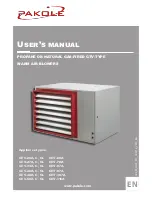
9
Operation Safety
Hydraulic Safety
1. Make sure that all the components in the hydraulic
system are kept in good condition and are clean.
2. Before applying pressure to the system, inspect
for leaks at all components, and that lines, hoses ,
connections and couplings are not damaged and leak
free.
3. Do not attempt any makeshift repairs to the
hydraulic lines, fittings or hoses by using tapes,
clamps or cements. The hydraulic system operates
under extremely high pressure. Such repairs will
fail suddenly and create a hazardous and unsafe
condition.
4. Wear proper hand and eye protection when searching
for a high pressure hydraulic leak. Use a piece of
wood or cardboard as a backstop instead of hands to
isolate and identify a leak.
5. If injured by a concentrated high-pressure stream of
hydraulic fluid, seek medical attention immediately.
Serious infection or toxic reaction can develop from
hydraulic fluid piercing the skin surface.
6. Relieve pressure on hydraulic system before
maintaining or working on system.
7. All hydraulic work must be done by
qualified
personnel.
Safe Work
Not all work spaces are the same, but the principles
presented here can be applied to any work space.
Survey the work site, remove debris and make note of
nearby or overhead obstructions, knowing your work area
will make the clearing job easier and safer.
Where possible, avoid operating near ditches,
embankments and holes.
For worker safety a preseason site visit is recommended.
Make a site clearing plan to identify hidden obstacles,
structures and piling areas. Sudden impact from obstacles
hidden under the snow may cause injury.
Be aware of:
Bystanders
or any one not directly involved with the
work are only allowed outside of the work area, minimized
hazards.
Workers
helping the operator must wear the appropriate
PPE and must always make eye contact with the operator
before entering the work area. Unauthorized Workers or
bystanders are not allowed in the work area. Hazards are
present.
Operator
, do not operate the snow blade outside of the
operator area.
Maintenance Safety
1. Good maintenance is your responsibility, follow the
maintenance schedule. Poor maintenance is an
invitation to trouble.
2. Follow good shop practices.
• Keep service area clean and dry.
• Be sure electrical outlets and tools are properly
grounded.
• Use adequate light for the job at hand.
3. Never work under or around the snow blade unless it
is braced securely.
4. Use personal protection equipment (PPE) such as
eye, hand and hearing protectors.
5. Never adjust, service, clean or lubricate the snow
blade until all power is shut off when attached to the
power unit.
6. Ensure hardware is torqued according to the torque
chart at the back of this manual.
7. Disconnect battery ground cable before servicing any
part of the electrical system.










































